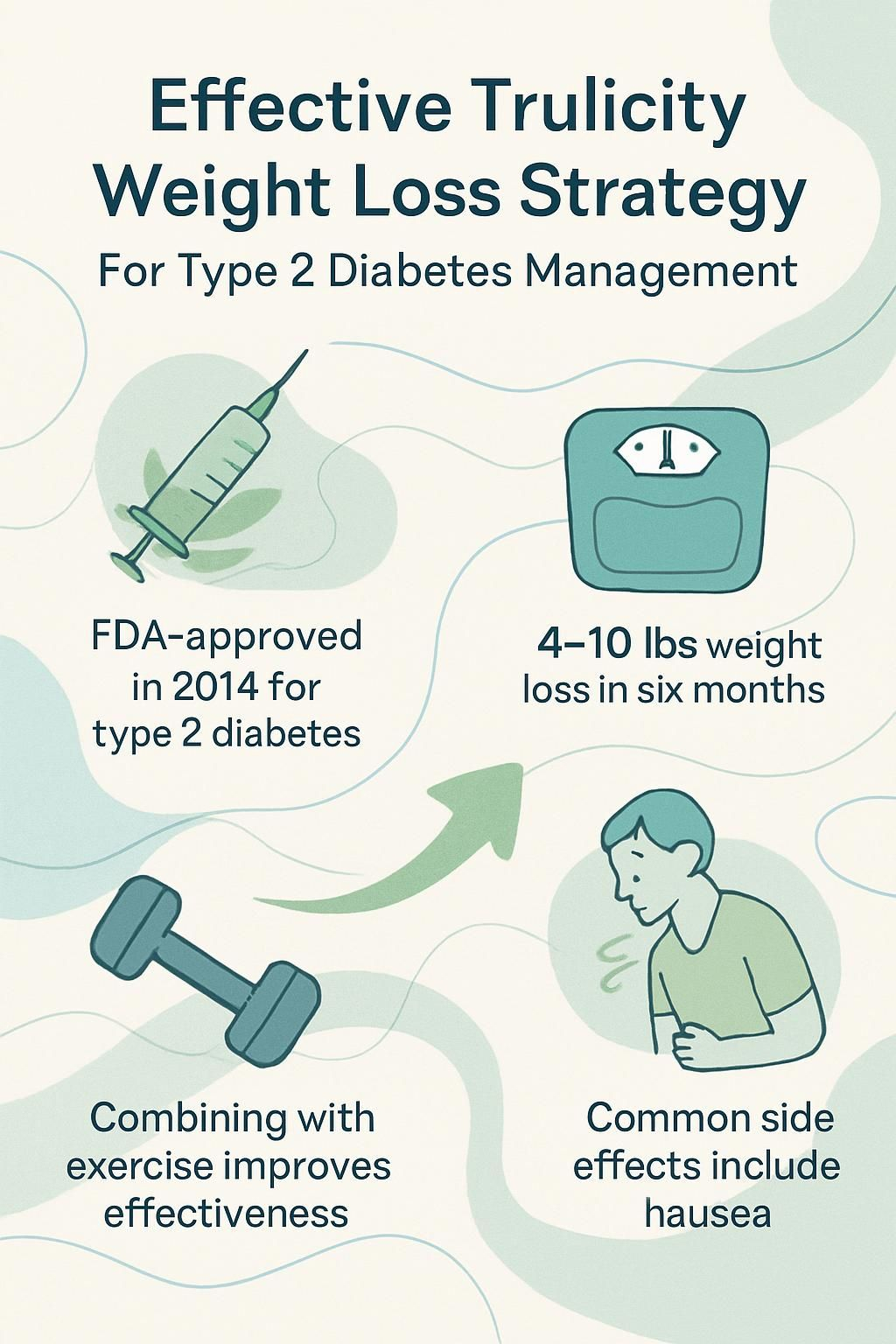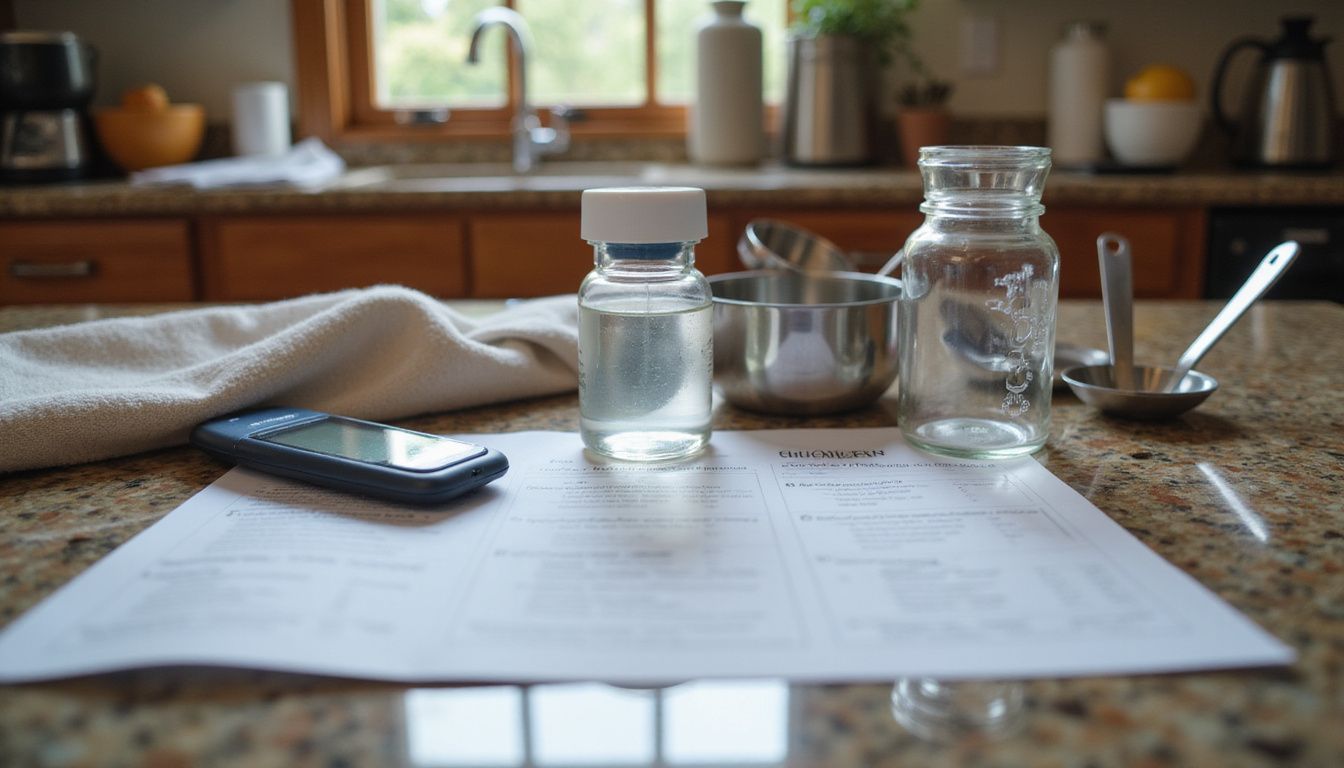Effective Trulicity Weight Loss Strategy For Type 2 Diabetes Management
Our Nutrition Assistant AI Suite will transform your body. You will lose fat, get toned, and build muscle. Gain confidence and optimal health.
If you live with type 2 diabetes, managing weight can feel exhausting. Trulicity weight loss strategies can help. Many adults see steadier blood sugar and gradual weight loss with this once-weekly medicine.
Research shows that trulicity users often lose a few pounds while improving glucose control. In this guide, you will learn how Trulicity works, what the studies show, and how simple habits can boost your results.
With a clear plan, you can take practical steps for better health.
Key Takeaways
- Trulicity, the brand name for dulaglutide, is a once-weekly GLP-1 receptor agonist that helps lower blood sugar and can support moderate weight loss in adults with type 2 diabetes.
- Clinical trials found average weight loss of about 4 to 10 pounds over 6 months, with larger reductions seen at higher doses such as 3 mg and 4.5 mg.
- Compared with some GLP-1 medicines like Ozempic, Trulicity is easy to use with an auto-injector, but tends to produce less average weight loss.
- Pairing Trulicity with high fiber foods, portion control, and regular activity can improve glucose control and reduce heart risk.
- Common side effects include queasiness and digestive upset. Rare risks such as pancreatitis and certain thyroid tumors require ongoing medical supervision.

What is Trulicity and How Does It Work?

Trulicity is a GLP-1 receptor agonist. That means it acts like the natural hormone GLP-1, which helps your body manage blood sugar after meals. It is taken as a once-weekly injection and may also support weight loss.
What is Dulaglutide?
Dulaglutide is the generic name for Trulicity. Doctors prescribe it to treat type 2 diabetes. It raises insulin after you eat, lowers the liver’s sugar output, and slows stomach emptying so glucose rises less after meals.
The Food and Drug Administration approved dulaglutide in 2014 for adults. Common starting doses are 0.75 mg or 1.5 mg once weekly. If needed, your provider may increase to 3 mg or 4.5 mg for greater glucose control.
“Using dulaglutide can lead to weight loss and improved blood sugar levels,” says Dr. Anne Peters from USC.
Next, see how GLP-1 receptor agonists create these effects inside your body.
When Was Trulicity Approved by the FDA?
Trulicity received FDA approval on September 18, 2014, for adults with type 2 diabetes. It offered a simpler, once-weekly option to lower blood sugar. Patients who needed more help later gained access to higher doses, 3 mg and 4.5 mg, in 2020.
Starting any new diabetes medication can feel uncertain. I began Trulicity soon after approval and noticed less hunger and a small drop in weight within weeks. Many patients report similar changes, especially when they pair the medicine with meal planning and movement.
Supportive trial data and real-world results helped establish Trulicity as a useful choice for glucose and weight goals.
How Does a GLP-1 Receptor Agonist Work?
GLP-1 receptor agonists copy the action of GLP-1, a hormone your gut releases after eating. Activating GLP-1 receptors tells your pancreas to release more insulin when glucose rises. It also reduces glucagon, a hormone that raises blood sugar, so overall levels run lower.
These medicines slow how quickly food leaves the stomach. You feel full longer and often eat less. I noticed fewer cravings within two weeks of starting Trulicity, which made smaller dinners easy most nights.
This appetite effect explains why many people lose weight while using a GLP-1 drug as part of their diabetes plan.
How Does Trulicity Help With Weight Loss?
Trulicity supports weight loss by working with your natural hunger signals. Many patients see a noticeable, steady weight change when they take the prescription as directed.
How Does Trulicity Regulate Appetite?
Dulaglutide mimics GLP-1, a hormone your gut releases after you eat. This sends a fullness signal to parts of your brain that control hunger. You tend to feel satisfied sooner, so you eat fewer calories.
The central nervous system responds by dialing down cravings. Many people notice less interest in snacks after a few weeks on a typical Trulicity dosage.
Patients treated with GLP-1 receptor agonists like trulicity reported reduced hunger and increased satiety, reports a 2022 review in *Diabetes, Obesity and Metabolism*.
In studies, adults using Trulicity for type 2 diabetes reported fewer urges to graze between meals. Smaller, balanced portions became easier to maintain.
This appetite control helps you stick with your nutrition plan and stay consistent with activity.
How Does Trulicity Reduce Calorie Intake?
After appetite improves, Trulicity helps reduce daily calorie intake by slowing stomach emptying. Food stays in the stomach longer, so the feeling of fullness lasts. Many people naturally eat smaller meals and skip second helpings.
Trials show that adults who take Trulicity and follow a healthy diet usually lower their calorie intake over time. In a randomized study, adults on 1.5 mg or higher doses lost more weight than those using some other diabetes medicines.
As treatment continues, your routine may shift to smaller portions and fewer snack cravings. This can help you reach weight goals while keeping glucose in range.
What Effect Does Trulicity Have on Digestion?
Trulicity slows how quickly your stomach empties food into the intestines. You feel full longer after meals. Early on, some users notice nausea, indigestion, vomiting, or loose stools. These effects often fade as your body adapts to the dose.
I felt mild queasiness the day after my first injection, and I filled up quickly at dinner. That full feeling helped me cut back without counting every bite.
This slowing of the gut is a key reason GLP-1 drugs help reduce calorie intake. Some people experience constipation or belly pain. Staying hydrated and eating fiber can help. Many users find that lighter meals and smaller portions work best while on dulaglutide.
Research Findings on Trulicity and Weight Loss
Clinical studies show Trulicity can help adults with type 2 diabetes lose weight, especially with higher doses. Here is what the research suggests.
What Do Clinical Trials Say About Trulicity?
Multiple trials show Trulicity can support weight loss in people with type 2 diabetes. In a 36-week randomized trial, average weight loss ranged from about 6.9 to 10.1 pounds, depending on the mg dose. Higher doses, like 3 mg and 4.5 mg, typically produced greater reductions than lower doses or placebo.
Many studies compare Trulicity with other GLP-1 medicines, including semaglutide and liraglutide. Trulicity often outperforms standard therapy alone, such as metformin without a GLP-1 drug, but tends to trail higher-dose semaglutide for weight change.
You may notice steady changes after several weeks. I tracked my starting weight and glucose weekly, as my pharmacist suggested. The most noticeable progress appeared around month three, which matches reports from many patients.
Summary Table: Weight Loss Results from Clinical Trials
| Dose of Dulaglutide | Average Weight Loss (pounds) | Duration |
|---|---|---|
| 0.75 mg | ~6 | 36 weeks |
| 1.5 mg | ~7 to 8 | 36 weeks |
| 3 mg or 4.5 mg | ~10 | Up to one year |
Trials also monitor side effects such as nausea and abdominal pain, as well as rare issues like pancreatitis. Most problems are mild, but regular monitoring is advised for all GLP-1 medicines used in type 2 diabetes.
What Weight Loss Results Have Been Observed?
In clinical studies, adults with type 2 diabetes who take Trulicity lose an average of 4 to 10 pounds over about six months. Higher doses, like dulaglutide 3 mg and 4.5 mg, tend to produce more visible changes than 0.75 mg or 1.5 mg.
As appetite drops and calorie intake falls, many people see a gradual decrease in body mass index. After switching to weekly dulaglutide with metformin, I lost about seven pounds in three months, even without major diet changes. Your results may vary depending on starting weight, dosing, and habits.
How Does Trulicity Compare to Other GLP-1 Medications?
Trulicity, Ozempic, and other GLP-1 receptor agonists are widely used for type 2 diabetes and weight control. Each has different dosing, strengths, and outcomes. Compare key features below.
| Feature | Trulicity (Dulaglutide) | Ozempic (Semaglutide) | Victoza (Liraglutide) | Bydureon (Exenatide ER) |
|---|---|---|---|---|
| FDA Approval Year | 2014 | 2017 | 2010 | 2012 |
| Dosing Frequency | Once weekly | Once weekly | Once daily | Once weekly |
| Weight Loss (Average) | Up to 6.6 lbs (3 kg) over 26 weeks1 | Up to 14.1 lbs (6.4 kg) over 40 weeks2 | Up to 6.6 lbs (3 kg) over 56 weeks3 | Up to 6.6 lbs (3 kg) over 28 weeks4 |
| Blood Sugar Reduction (HbA1c) | 0.9% – 1.5% | 1.0% – 1.8% | 0.8% – 1.5% | 0.7% – 1.5% |
| Cardiovascular Benefits | Yes (reduces risk of major adverse CV events) | Yes (reduces CV events in high-risk patients) | Yes (reduces CV events in high-risk patients) | Not formally proven |
| Common Side Effects | Nausea, vomiting, diarrhea | Nausea, vomiting, diarrhea | Nausea, vomiting, diarrhea | Nausea, diarrhea, injection site reactions |
| Ease of Use | Auto-injector, no mixing required | Pen injector, no mixing required | Pen injector, daily use | Requires mixing before use |
| Indications | Type 2 diabetes, risk reduction of CV events | Type 2 diabetes, risk reduction of CV events | Type 2 diabetes, risk reduction of CV events | Type 2 diabetes |
- Trulicity offers weekly dosing with an easy auto-injector and can reduce both weight and HbA1c.
- Ozempic often delivers greater average weight loss and stronger HbA1c reduction for many patients.
- Victoza requires daily injections and is approved for children 10 and older with type 2 diabetes.
- Bydureon must be mixed before use and lacks formal cardiovascular outcome data.
Lifestyle Changes to Improve Trulicity Results
Healthy habits can magnify your results while using Trulicity for type 2 diabetes. Even small steps matter when done consistently.
What Diet Changes Enhance Trulicity’s Effectiveness?
Nutrition choices shape your glucose and weight outcomes. Use these steps to support your plan.
- Focus on fiber from whole grains, vegetables, and beans. Fiber slows digestion and helps prevent sharp glucose spikes.
- Limit sugary drinks and refined snacks. This helps lower A1C and trims calories.
- Choose lean proteins like chicken, fish, eggs, tofu, or beans. Protein helps you feel full and protects muscle during weight loss.
- Control portions with smaller plates or measuring cups. Simple tools prevent creep in serving sizes.
- Eat regular, balanced meals. Skipping meals can raise hypoglycemia risk, especially with other diabetes drugs.
- Drink water instead of juice or soda. Cutting liquid sugar is an easy calorie win.
- Watch sodium intake. High salt plus dehydration can strain the kidneys.
- Reduce deep-fried and high-fat fast foods. Extra fat can raise heart risk and slow your progress.
- Keep a food journal for a week. You will spot patterns and triggers that cause overeating.
- Pick nutrient-dense snacks, such as nuts, yogurt, berries, or fruit. These satisfy hunger without heavy sugar.
Each change supports Trulicity’s effects on appetite and blood sugar control.
How Does Exercise Support Weight Management with Trulicity?
Movement enhances the benefits of GLP-1 therapy. Start with simple, consistent activities that you enjoy.
- Burn extra calories with brisk walks, cycling, swimming, or yard work. Moderate activity adds up over a week.
- Exercise improves insulin sensitivity, which strengthens Trulicity’s glucose-lowering effect.
- People who move regularly often lose more weight than those who rely on medicine alone.
- Light walking and stretching may ease constipation and mild stomach discomfort.
- Activity boosts mood and lowers stress, which makes healthy habits easier to keep.
- Even short routines protect heart health, an important goal for people with diabetes.
- Track workouts with an app or notebook. Seeing progress helps you stay consistent.
- Talk with your healthcare professional before starting, especially if you have kidney disease, gallbladder issues, or joint problems.
How Can You Track Health Improvements During Treatment?
Regular tracking shows what is working and where to adjust. It also gives your care team better data.
- Check fasting and post-meal blood sugar with a reliable meter. Log readings to spot trends.
- Weigh in weekly under similar conditions. Many users lose several pounds over a few months.
- Record meals and calories. Trulicity may reduce appetite, and logs show how eating patterns change.
- Note side effects such as nausea or injection site irritation. Write down dates and severity.
- Log activity, including type and duration. Movement improves outcomes and mood.
- Keep up with labs, including HbA1c, cholesterol, and kidney function. Add the results to your log.
- Track blood pressure if you have a cuff at home. Better numbers often follow improved glucose control.
- Report trouble swallowing or a hoarse voice. Rare thyroid concerns should be checked promptly.
- Record every dose. Include the dosage, such as 0.75 mg or higher, and the injection site.
- Use progress photos every month. Visual changes can be motivating.
- Write a short weekly summary on energy, sleep, and mood. Small wins often appear here first.
Benefits of Trulicity for Diabetes Management
Trulicity is an effective diabetes medication that lowers blood sugar in adults with type 2 diabetes. Many patients also experience weight loss as part of a complete care plan.
How Does Trulicity Help Regulate Blood Sugar?
You inject Trulicity once a week. As a GLP-1 receptor agonist, it triggers the pancreas to release more insulin when blood sugar rises after meals. It also reduces glucagon, which lowers sugar made by the liver between meals.
Food moves through the stomach more slowly, which helps avoid sharp glucose spikes. Trials show Trulicity improves A1C and day-to-day glucose compared with placebo. Many people report steadier energy and fewer highs and lows.
What Cardiovascular Benefits Does Trulicity Provide?
GLP-1 receptor agonists have been studied for heart protection. In the REWIND trial, dulaglutide lowered major cardiovascular events compared with placebo in adults with type 2 diabetes, including those without known heart disease.
Your provider may recommend Trulicity if you have heart disease or high risk. After starting, some patients see better blood pressure and healthier cholesterol levels. My doctor suggested it when my A1C and LDL rose, and both improved over several months.
These benefits come from improved glucose control, weight loss, and direct effects on the cardiovascular system.
How Does Trulicity Address Weight-Related Health Issues?
Trulicity helps reduce appetite and food intake, which encourages gradual weight loss. Even modest weight loss can improve glucose control in type 2 diabetes. In trials, many adults lost 6 pounds or more after several months.
Less weight lowers the risk tied to high blood pressure, heart disease, and stroke. I have seen patients who struggled with dieting alone begin to progress after adding once-weekly dulaglutide. More energy often follows, which makes exercise and meal planning easier.
Guidelines for Taking Trulicity
Good technique and a steady routine support safe and effective use. Follow your care team’s instructions closely.
How Often Should Trulicity Be Administered?
Trulicity is taken once each week by subcutaneous injection. Most people choose the same day and time every week to stay consistent. Pens come in 0.75 mg, 1.5 mg, 3 mg, and 4.5 mg doses.
Inject into the abdomen, thigh, or upper arm after you learn the steps from your healthcare provider. Keeping a regular schedule helps with blood sugar and weight progress. The next section explains your dosing choices.
What Dosage Options Are Available?
Several once-weekly doses are available. Many adults start at 0.75 mg. If goals are not met, your provider may increase to 1.5 mg, 3 mg, or 4.5 mg. Starting lower can reduce early stomach side effects.
Your dose may change based on your A1C, side effects, and weight goals. I began at 0.75 mg and increased later as my body adjusted. Report new symptoms right away, especially neck swelling or a hoarse voice, because those can signal rare thyroid concerns.
Next, learn simple injection best practices to improve comfort and safety.
What Are Best Practices for Trulicity Injection?
- Wash your hands before handling the pen to reduce infection risk.
- Check the pen for the expiration date, color changes, or particles. Do not use a damaged pen.
- Choose a clean site on the thigh, abdomen, or upper arm. Rotate locations each week.
- Hold the pen at a 90-degree angle against the skin before pressing the button.
- Press and hold until you hear a click, then count to five to ensure a full dose.
- Place the used pen in a sharps container right after use.
- Take the prescribed dose, such as 0.75 mg or 1.5 mg, on the same day each week.
- Report redness, pain, or swelling at the injection site to your provider.
- Store pens in the fridge; let a pen warm to room temperature before injecting.
- Track injection dates and any reactions in a simple log.
- Follow your care team’s directions to support weight loss and blood sugar control.
What Are the Side Effects and Precautions of Trulicity?
Most side effects are mild and improve with time. Serious reactions are rare, but you should know the signs. This information supports safe use.
What Common Side Effects Should Patients Expect?
Many people feel mild nausea in the first weeks. Other common issues include stomach pain, diarrhea, vomiting, reduced appetite, heartburn, constipation, or fatigue. These symptoms usually fade as your body adapts.
Occasional injection site redness or swelling can occur. Some users notice small changes in blood sugar or mild allergic reactions. In clinical trials, most side effects were temporary and manageable. Severe symptoms, such as intense abdominal pain or sudden vision changes, need prompt medical care.
What Serious Health Risks Are Associated With Trulicity?
Dulaglutide has rare but serious risks. These can include pancreatitis, severe allergic reactions, and possible thyroid tumors in people at risk. Symptoms can include severe stomach pain, vomiting, facial swelling, a neck lump, or a hoarse voice. The FDA includes warnings on the label for these concerns.
Low blood sugar can occur, especially if Trulicity is combined with insulin or a sulfonylurea. There have been reports of kidney problems and serious digestive issues such as dehydration. Stop the medicine and seek care if you notice warning signs like a neck mass or trouble swallowing.
Table: Serious Health Risks Associated With Trulicity
| Health Risk | Description |
|---|---|
| Pancreatitis | Inflammation of the pancreas with severe stomach pain and vomiting |
| Medullary Thyroid Cancer | Increased risk for certain people, watch for neck lumps or hoarseness |
| Multiple Endocrine Neoplasia | High risk if you have MEN type 2 |
| Hypoglycemia | Low blood sugar, especially with insulin or sulfonylureas |
| Kidney Problems | Reports of reduced kidney function or failure |
| Severe Allergic Reactions | Swelling, hives, or trouble breathing |
Doctors recommend regular monitoring to catch rare issues early. Share your personal and family history with your provider before starting dulaglutide.
Why Is Ongoing Health Supervision Important?
Ongoing supervision allows your clinician to track your response and adjust dosing as needed. Your provider can watch for side effects such as nausea or appetite changes and check labs for safety.
Routine visits help spot rare risks such as thyroid concerns or hypoglycemia if you use other glucose-lowering drugs. I discovered early digestive issues during a routine check, which helped my team adjust the plan before problems grew. That kind of feedback keeps your treatment safe and effective.
Next, review who may be a good candidate for this medicine.
Who Is Eligible to Use Trulicity for Weight Management?
Eligibility depends on your medical history and current health status. Discuss these points with your provider before starting.
What Are the Criteria for Using Trulicity?
- You have type 2 diabetes, which Trulicity is approved to treat in adults.
- You are 18 or older unless a specialist advises otherwise.
- Lifestyle steps alone have not controlled your blood sugar.
- You do not have type 1 diabetes or diabetic ketoacidosis.
- You are not pregnant or breastfeeding.
- You have no personal or family history of medullary thyroid carcinoma or MEN type 2.
- Your kidney and liver function are checked regularly as directed.
- You can inject a once-weekly dose correctly.
- You agree to regular follow-up to monitor side effects and benefits.
- You disclose any past pancreatitis, severe digestive problems, or allergies before starting.
- You understand that using Trulicity only for weight loss is off-label and may not be covered by insurance.
I started Trulicity after my A1C rose despite meal changes. My first prescription included lab checks to confirm safety before the first injection.
Can Non-Diabetics Use Trulicity for Weight Loss?
Doctors prescribe Trulicity for type 2 diabetes, not for weight loss alone. The FDA has not approved it for people without diabetes. Some may try off-label use, but experts question safety and coverage for those without diabetes.
GLP-1 drugs often reduce appetite, which can lead to weight loss. Still, many insurance plans do not cover dulaglutide for non-diabetic use. Other options that have FDA approval for obesity treatment include semaglutide and tirzepatide under specific brands. Speak with a clinician about the safest choice for you.
What Are the Contraindications for Trulicity?
Certain health conditions make Trulicity unsafe. Review these with your provider before you start.
- A personal or family history of medullary thyroid carcinoma
- Multiple endocrine neoplasia syndrome type 2
- A serious allergy to dulaglutide or its ingredients
- Use of another GLP-1 receptor agonist or certain combinations that raise risk
- Severe gastrointestinal disease, such as gastroparesis
- Recent pancreatitis or a history that suggests higher risk
- Use for weight loss without diabetes requires careful medical oversight
Your provider will weigh risks and benefits based on your full medical history.
Comparing Trulicity to Other GLP-1 Medications
Comparing options helps you and your clinician pick the best fit for your goals. Dosing, side effects, and weight outcomes can differ across GLP-1 drugs.
How Does Trulicity Compare to Ozempic?
Both medicines manage type 2 diabetes and are taken weekly. In studies, Ozempic often shows larger average weight loss than Trulicity. Results for Ozempic can reach about 12 to 15 pounds, while Trulicity averages closer to 6 to 10 pounds.
Each reduces appetite and improves glucose control. Side effects such as nausea and stomach upset are similar. A friend of mine did better with Ozempic for weight loss, while I did well on Trulicity for glucose stability. Your best choice depends on goals, coverage, and side effect tolerance.
Next, review key differences between dulaglutide and semaglutide.
What Are the Differences Between Trulicity and Semaglutide?
Both are GLP-1 receptor agonists given by injection. Trulicity, which contains dulaglutide, is FDA approved for type 2 diabetes but not for weight loss. The maximum commonly used dose is 4.5 mg weekly.
Semaglutide is sold as Ozempic for diabetes and Wegovy for weight loss. Higher doses of semaglutide used for weight management often produce more weight loss than Trulicity. Appetite suppression tends to be stronger with semaglutide at those doses.
Talk with your clinician about which matches your targets, medical history, and budget.
How Do Effectiveness and Safety Compare Across These Medications?
Trials show semaglutide often leads to more weight loss than Trulicity. Some participants on semaglutide lost up to about 12 percent of their body weight. Trulicity users often averaged around half of that reduction.
Both medicines can cause decreased appetite, queasiness, and stomach upset. Serious risks like pancreatitis are rare but possible. Starting at a lower dose and tracking symptoms can improve comfort. Adjusting your diet while on a GLP-1 drug often helps you tolerate it better.
Tips for Maximizing Weight Loss With Trulicity
You can improve Trulicity results with clear routines, small habit shifts, and regular check-ins. Simple actions add up over time.
How Can You Maintain Consistency With Treatment?
- Pick a fixed day and time each week for your injection.
- Set phone or calendar reminders to prevent missed doses.
- Store the pen in a visible spot in the fridge as a cue.
- Keep a simple journal of injections, side effects, and appetite changes.
- Discuss adherence at each visit for support and troubleshooting.
- Link injection day with a weekly task, like meal planning.
- Prep supplies in advance so you never rush the steps.
- Ask a friend or family member to check in on your progress.
- Flag side effects early so your provider can adjust your plan.
- Celebrate small streaks, like four weeks of on-time injections.
I tie my injection to Sunday meal prep. It keeps my routine steady and makes planning food for the week easier.
How Can Side Effects Be Managed Effectively?
- Tell your healthcare provider about all side effects. Early changes can prevent bigger problems.
- Take your dose on the same day and time each week to keep a rhythm.
- Eat smaller, lighter meals if you feel queasy or overly full.
- Drink extra water to ease constipation or dizziness.
- Use reminders so you do not miss doses.
- Track weight, digestion, and appetite in a short daily note.
- Ask if a dose change or an anti-nausea option could help.
- Seek urgent care for severe stomach pain, swelling, or trouble breathing.
- Review all medicines and supplements to avoid interactions.
These steps can reduce discomfort and keep you on track for results.
Why Work Closely With Health Professionals?
Your care team helps you use Trulicity safely and effectively. They can tailor your dosage, manage side effects, and coordinate labs. My nurse once spotted early nausea patterns and adjusted timing, which made a big difference.
Strong support is linked to better glucose control and more weight loss. Your clinician can also explain whether any off-label use is right for you and how it fits with other medicines.
Conclusion
A thoughtful Trulicity weight loss strategy can support better control of type 2 diabetes. Pair the medicine with balanced meals, regular activity, and a consistent weekly routine. Clinical studies show that Trulicity helps regulate appetite and improve blood sugar levels in adults with type 2 diabetes.
Side effects can occur, so keep close contact with your healthcare provider. Track your weight, glucose, and symptoms to see progress early. With steady habits and guidance, you can lose weight safely, improve glucose control, and protect your long-term health.
FAQs
1. How does Trulicity help with weight loss in people with type 2 diabetes?
Trulicity targets a specific receptor in the body that helps control blood sugar and appetite. Some people experience anorexia, or loss of appetite, which can lead to weight loss measured in pounds. Clinical studies show that Trulicity can support weight loss, but results vary for each person. Trulicity is not approved for weight loss alone, but doctors may prescribe it off-label for this purpose in certain cases.
2. What is the importance of adherence to Trulicity in managing type 2 diabetes and weight?
Adherence to Trulicity means taking the medication as prescribed. Consistent use helps regulate blood sugar and may support weight loss. Missing doses can reduce the effectiveness of the medicine and may affect both diabetes control and weight management. Research shows that people who follow their treatment plan closely often see better results.
3. Are there risks or side effects when using Trulicity for weight loss?
Trulicity can cause side effects such as nausea, anorexia, and stomach discomfort. Some people may lose too much weight or experience other symptoms. It is important to talk with a healthcare provider before using Trulicity, especially if considering it off-label for weight loss. Monitoring is needed to ensure safety and effectiveness.
4. How much weight can a person expect to lose with Trulicity?
Weight loss varies based on individual factors such as diet, activity, and adherence to medicine. Studies report average weight loss ranging from a few to several pounds over several months. Trulicity is not a substitute for healthy eating and exercise. It works best as part of a complete diabetes management plan.
Summary: Trulicity acts on a specific receptor to help control blood sugar and appetite in type 2 diabetes. Adherence is key for best results. Some people lose weight, but side effects like anorexia can occur. Weight loss varies, and medical guidance is important when using Trulicity off-label for this purpose.







